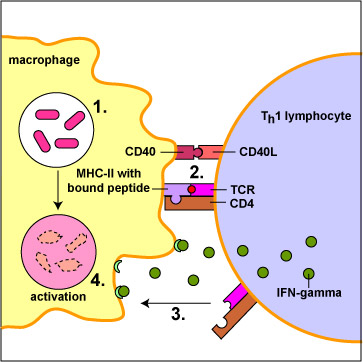
1. Engulfed bacteria inside a phagosome
or a phagolysosome.
2. An activated Th1 lymphocyte binds to a peptide/MHC-II complex
on a macrophage by way of its TCR and CD4 molecule. Co-stimulatory molecules
such as CD40L on the Th1 cell then bind to CD40
on a macrophage.
3. This triggers the Th1 lymphocyte to secrete the cytokine interferon-gamma
(IFN-gamma) that binds to IFN-gamma receptors receptors on the macrophage.
4. The IFN-gamma activates the macrophage enabling it to produce more hydrolytic
lysosomal enzymes, nitric oxide, and toxic oxygen radicals that destroy the
microorganisms within the phagosomes and phagolysosomes.
Last updated: August, 2019
Please send comments and inquiries to Dr.
Gary Kaiser